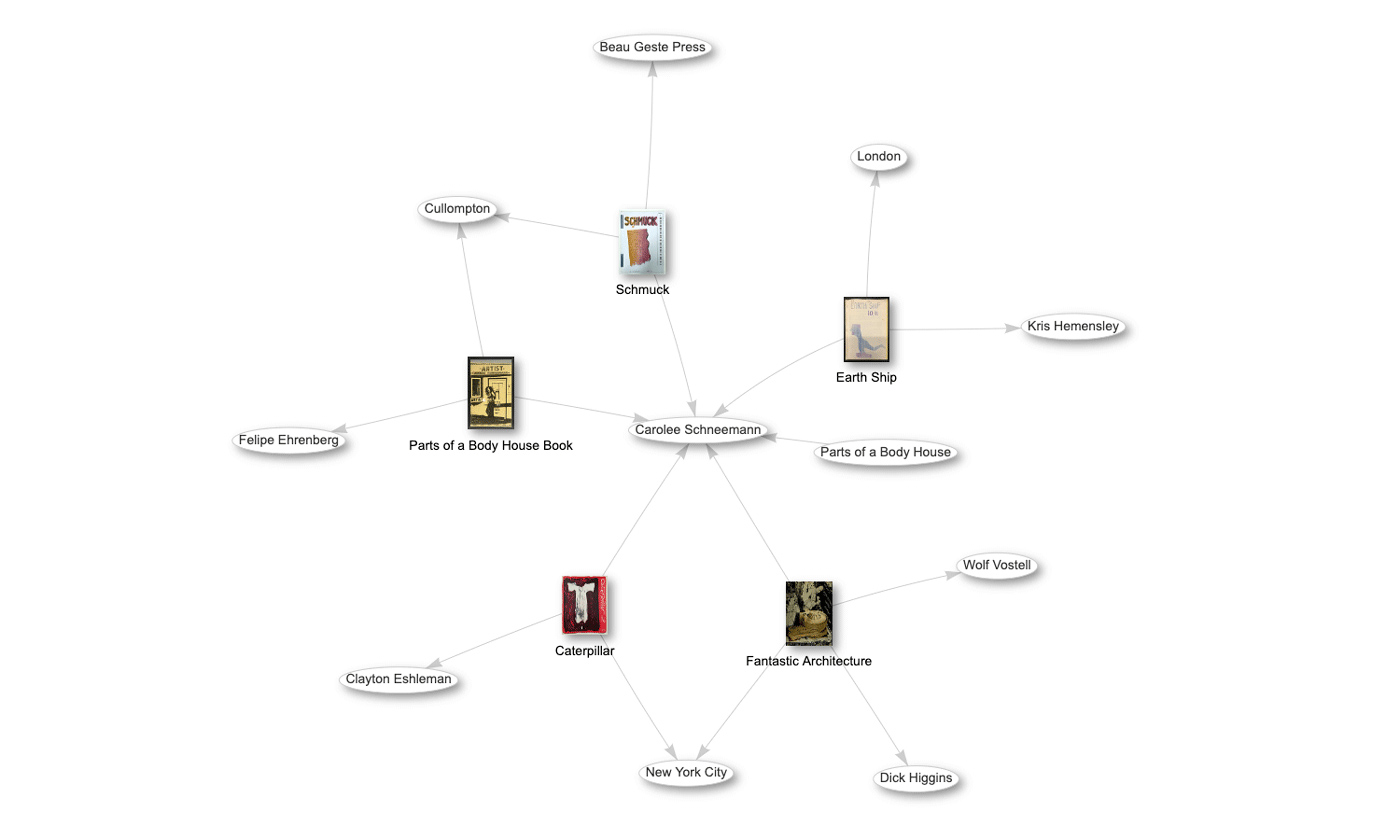Carolee Schneemann case study: Difference between revisions
(Created page with "''Text by [https://www.tate.org.uk/research/studentships/current/karen-di-franco Dr Karen di Franco]'' The source material for this group of publications is based on research...") |
mNo edit summary |
||
| (6 intermediate revisions by 2 users not shown) | |||
| Line 1: | Line 1: | ||
=A case study describing and connecting publications by Carolee Schneemann= | |||
https://daap.bannerrepeater.org/w/images/e/ed/Case-study-diagram-viz.jpg | |||
''Text by [https://www.tate.org.uk/research/studentships/current/karen-di-franco Dr Karen di Franco]'' | ''Text by [https://www.tate.org.uk/research/studentships/current/karen-di-franco Dr Karen di Franco]'' | ||
The source material for this group of publications is based on research undertaken for my PhD thesis, titled ''Embodied Iteration: Materialising the Language of Writing and Performance in Women Artists’ Publishing, 1968–1977''. The research centres ''embodied iteration'' as a descriptive term to denote heterogeneity within the processes of making and siting artworks that are located in variety of interconnected published materials, as well as a methodological process that accounts for the development of a work/or works, reconnecting materials to their published location, re-establishing relationships to publishers, designers and editors as well as the material concerns of print itself. | The source material for this group of publications is based on research undertaken for my PhD thesis, titled ''Embodied Iteration: Materialising the Language of Writing and Performance in Women Artists’ Publishing, 1968–1977''. The research centres ''embodied iteration'' as a descriptive term to denote heterogeneity within the processes of making and siting artworks that are located in variety of interconnected published materials, as well as a methodological process that accounts for the development of a work/or works, reconnecting materials to their published location, re-establishing relationships to publishers, designers and editors as well as the material concerns of print itself. | ||
The five publications included in DAAP are connected by the inclusion of the text | The five publications included in DAAP are connected by the inclusion of the text ‘Parts of a Body House’ by Carolee Schneemann. This text, itself written over a duration, between 1957-67, was first published in the experimental writing journal, [https://daap.network/artwork?id=Q428 ''Caterpillar''] (1968), then in the pop architecture anthology [https://daap.network/artwork?id=Q430 ''Fantastic Architecture''] (1969); Schneemann’s own artist book [https://daap.network/artwork?id=Q368 ''Parts of a Body House Book''] (1972); the assembling magazine, [https://daap.network/artwork?id=Q433 ''Schmuck''] (1972) and the poetry magazine, [https://daap.network/artwork?id=Q435 ''Earth Ship''] (1972). | ||
These books are not located in any one place, or collection, they are separated across the library and archive, and therefore subject to different forms of categorisation. This digital collection allows for contextual associations such as this to be made, which extends notions of the relevancy of publishing in its expanded form, specific to its production in the UK, yet connected and descriptive of an international network of practitioners. | These books are not located in any one place, or collection, they are separated across the library and archive, and therefore subject to different forms of categorisation. This digital collection allows for contextual associations such as this to be made, which extends notions of the relevancy of publishing in its expanded form, specific to its production in the UK, yet connected and descriptive of an international network of practitioners. | ||
''See a [https://tinyurl.com/ | ''See a [https://tinyurl.com/2c3yf54u visualization] of some of the data added to the DAAP for this case study.'' | ||
Latest revision as of 16:54, 11 December 2022
A case study describing and connecting publications by Carolee Schneemann

Text by Dr Karen di Franco
The source material for this group of publications is based on research undertaken for my PhD thesis, titled Embodied Iteration: Materialising the Language of Writing and Performance in Women Artists’ Publishing, 1968–1977. The research centres embodied iteration as a descriptive term to denote heterogeneity within the processes of making and siting artworks that are located in variety of interconnected published materials, as well as a methodological process that accounts for the development of a work/or works, reconnecting materials to their published location, re-establishing relationships to publishers, designers and editors as well as the material concerns of print itself.
The five publications included in DAAP are connected by the inclusion of the text ‘Parts of a Body House’ by Carolee Schneemann. This text, itself written over a duration, between 1957-67, was first published in the experimental writing journal, Caterpillar (1968), then in the pop architecture anthology Fantastic Architecture (1969); Schneemann’s own artist book Parts of a Body House Book (1972); the assembling magazine, Schmuck (1972) and the poetry magazine, Earth Ship (1972).
These books are not located in any one place, or collection, they are separated across the library and archive, and therefore subject to different forms of categorisation. This digital collection allows for contextual associations such as this to be made, which extends notions of the relevancy of publishing in its expanded form, specific to its production in the UK, yet connected and descriptive of an international network of practitioners.
See a visualization of some of the data added to the DAAP for this case study.